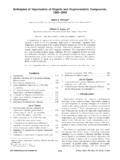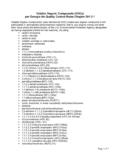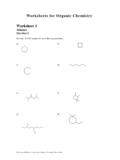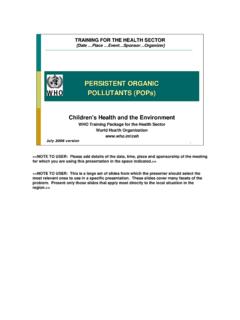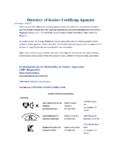Transcription of CHAPTER 1 INTRODUCTION TO ORGANIC …
1 CHAPTER 1 INTRODUCTION TO ORGANIC Historical Background of ORGANIC ChemistryOrganic chemistry is the area of chemistry that involves the study of carbonand its compounds. Carbon is now known to form a seemingly unlimited numberof compounds. The uses of ORGANIC compounds impact our lives daily in medicine,agriculture, and general theory (Oparin, 1923) ORGANIC chemistry may have its beginnings with thebig bang when the components of ammonia, nitrogen, carbon dioxide and methanecombined to form amino acids, an experiment that has been verified in the laboratory(Miller, 1950). ORGANIC chemicals were used in ancient times by Romans andEgyptians as dyes, medicines and poisons from natural sources, but the chemicalcomposition of the substances was the 16th century ORGANIC compounds were isolated from nature in the purestate (Scheele, 1769) and analytical methods were developed for determination ofelemental composition (Lavoisier, 1784).Scientists believed (Berzelius, 1807) that ORGANIC chemicals found in naturecontained a special "vital force" that directed their natural synthesis, and therefore, itwould be impossible to accomplish a laboratory synthesis of the , later in the century Frederich W hler (1828) discovered that urea, anatural component in urine, could be synthesized in the laboratory by heatingammonium cyanate.
2 His discovery meant that the natural "vital force" was notrequired to synthesis ORGANIC compounds, and paved the way for many chemists tosynthesize ORGANIC the middle of the nineteenth century many advances had been made intothe discovery, analysis and synthesis of many new ORGANIC about the structures of ORGANIC chemistry began with a theory ofbonding called valence theory (Kekule, Couper, 1858). ORGANIC chemistry developed into a productive and exciting science in thenineteenth century. Many new synthetic methods, reaction mechanisms, analyticaltechniques and structural theories have been developed. Toward the end of thecentury much of the knowledge of ORGANIC chemistry has been expanded to the2 Ch 1 Introductionstudy of biological systems such as proteins and DNA. Volumes of information arepublished monthly in journals, books and electronic media about ORGANIC andbiological vast information available today means that for new students of organicchemistry a great deal of study is required.
3 Students must learn about organicreactions, mechanism, synthesis, analysis, and biological study of ORGANIC chemistry , although complex, is very interesting, andbegins here with an INTRODUCTION of the theory of chemical The Chemical Atomic TheoryThe atomic theory of electrons began in the early 1900s and gainedacceptance around 1926 after Heisenberg and Schroedinger found mathematicalsolutions to the electronic energy levels found in atoms, the field is now calledquantum exist in energy levels that surround the nucleus of the atom. Theenergy of these levels increases as they get farther from the nucleus. The energylevels are called shells, and within these shells are other energy levels, calledsubshells or orbitals., that contain up to two electrons. The calculations fromatomic theory give the following results for electron energy and orbitals. The resultsfor the first two energy levels (shells 1 and 2) are the most important for bonding inorganic chemistry .
4 OrbitalsShellsp dfTotal Electrons Possible112223833351841 35732*energy level 1 contains up to two electrons in a spherical orbital called a 1s orbital.*energy level 2 contains up to eight electrons; two in an 2s-orbital and two in each of three orbitals designated as 2p-orbitals. The p-orbitals have Bonding 3a barbell type shape and are aligned along the x, y, and z axes. They are thus called the px, py, and pz orbitalxyz2s orbital2px orbital2py orbital2pz orbital*energy level 3 contains up to eighteen electrons, two electrons in a 3s orbital, six electrons in the three 3p orbitals, and ten electrons in the five 3dorbitals.*energy level 4 contains up to thirty-two electrons, two electrons in a 4s-orbital, six electrons in the three 4p-orbitals, ten electrons in the five 4d-orbitals, and fourteen electrons in the seven fill the lower energy levels first until all of the electrons are used (Aufbau Principle).
5 An element contains the number of electrons equal to itsatomic number. For the first and second row elements the electron configurationsare relatively (atomic number)Electron ConfigurationH (1)1s1 (1st shell, s orbital, one electron)He (2)1s2Li (3)1s2, 2s14 Ch 1 IntroductionBe (4)1s2, 2s2B (5)1s2, 2s2, 2p1C (6)1s2, 2s2, 2p2N (7)1s2, 2s2, 2p3O (8)1s2, 2s2, 2p4F (9)1s2, 2s2, 2p5Ne (10)1s2, 2s2, 2p6 (inert, completely filled) ElectronegativityElectronegativity is the ability of an atom to attract electrons to itself, andgenerally increases as one moves from left to the right across the periodic table. least mostelectronegative Li < Be < B < C < N < O < F electronegativeElectronegativity also increases as we go from the bottom to the top of acolumn in the periodic mostelectronegative I < Br < Cl < F electronegativeElements that easily lose electrons and attain a positive charge are calledelectropositive elements.
6 Alkali metals are electropositive BondingAtoms can become bonded with each other, and their electronic structuregoverns the type of bond formed. The main two types of bonds that are formed arecalled ionic and BondIonic bonding is important between atoms of vastly differentelectronegativity. The bond results from one atom giving up an electron whileanother atom accepts the electron. Both atoms attain a stable nobel gasconfiguration. Bonding 5 In the compound lithium fluoride, the 2s1 electron of lithium is transferredto the 2p5 orbital of fluorine. The lithium atom gives up an electron to form thepositively charged lithium cation with 1s2, 2s0 configuration, and the fluorineatom receives an electron to form a fluoride anion with 1s2, 2s2, 2p6 the outer energy levels of both ions are completely filled. The ions are heldtogether by the electrostatic attraction of the positive and negative +LiF1 s22 s22 p52 s11 s21 s22 s02 s22 p61 s2 Covalent BondA covalent bond is formed by a sharing of two electrons by two hydrogen atom possessing the 1s1 electron joins with another hydrogen atomwith its 1s1 configuration.
7 The two atoms form a covalent bond with two electronsby sharing their +HHIn hydrogen fluoride, HF, the hydrogen 1s electron is shared with a 2p5electron in fluorine (1s2, 2s2, 2p5), and the molecule is now held together by acovalent bond. In this case, the fluorine atom is much more electronegative than thehydrogen atom and the electrons in the bond tend to stay closer to the fluorine is called a polar covalent bond, and the atoms possess a small partial chargedenoted by the Greek symbol6 Ch 1 IntroductionH1s1F2s22p5 HFeight outer electronstwo sharedsix non-bondingHF +Polar Covalent Bonding in Carbon CompoundsThe property of carbon that makes it unique is its ability to form bonds withitself and therefore allows a large number of ORGANIC chemicals with many diverseproperties. Carbon has the property of forming single, double and triple bonds withitself and with other atoms. This multiple bond ability allows carbon compounds tohave a variety of shapes.
8 In all carbon compounds, carbon forms four bonds. Thetypes of bonds used by the carbon atom are known as sigma () and pi () combinations of these bonds lead to carbon single bonds, double bondsand triple The Carbon-Hydrogen Single Bond-The Sigma () BondBy far most of the bonds in carbon compounds are covalent bonds foundcommonly in the carbon-hydrogen single bond. In carbon (1s2, 2s2, 2p2) one ofthe electrons of the 2s2 orbital is promoted to the third 2p0 orbital. The s and threep orbitals hybridize to form four new orbitals of equal energy called sp3 hybridorbitals. The electrons in the four sp3 hybridized orbitals bond by overlap with the1s1 hydrogen orbital. The single covalent bond is called a sigma () bond. Thesp3 bonds arrange themselves as far from each other as possible, the shape of amolecule of methane, CH4, is tetrahedral with bond angles. Bonding in Carbon 71s2 CCARBON--sp3 HYBRIDIZED2p2 Promote 1s2 to 2p1s12p3mix all orbitalsequal energyFour equivalent sp3 Hybridized OrbitalsHHHH tetrahedralMETHANE, CH4equivalent sp3 1s orbitalSigma ( ) BondsThe unique property of carbon that differentiates it from the other elementsand allows the formation of so many different ORGANIC compounds is the ability ofcarbon to bond with itself through covalent bonding.
9 Thus, addition of anothercarbon atom to methane results in ethane which has covalent sigma bonds to thehydrogen atoms and a covalent sigma bond between the carbon atoms. Addition ofmore carbon atoms leads to many more compounds. 8 Ch 1 IntroductionEthaneHHHHHHC arbon-carbon sigma The Carbon-Carbon Double Bond-The Pi () BondCarbon forms a wide variety of compounds that contain carbon bonded toanother carbon with a double bond between the two atoms. These compounds areclassified as alkenes (older naming calls them olefins). The orbital model belowexplains the carbon-carbon double bond. The carbon electron configuration showsone s electron being promoted to a p orbital. But now only three orbitals are mixed,a s orbital and two p orbital, that are called sp2 hybrid orbitals and are used to formsingle bonds (sigma bonds). The p orbital contains one combination of two of the sp2 hybridized carbon atom leads to twocarbon atoms being joined by overlap of sp2 orbitals to form a C-C single bond, andthe side-to-side overlap of the p orbitals to form another bond known as a pi ()bond.
10 In the molecule of ethene shown below there are a total of 5 sigma bondsand one pi bond. As a result of the bonding in an ethene, the molecule is planar withbond angles of 120o and a C=C bond length that is longer than the C-H bondlength. Bonding in Carbon 91s2 CCARBON--sp2 HYBRIDIZED2p2 Promote 1s2 to 2p1s12p3 Mix the !swith two of the 2pleave one p unhybridizedthree sp2 hybridized orbitals2pETHENE CH2=CH2sp2 orbitalsp orbital(top and bottom)HHHHBond(top and bottom forms one -bondSigma ( ) bondssp2 hybridized carbonHHHHHHHH Aplanarsp2 hybridWhen carbon forms a bond with an electronegative atom such as oxygen,nitrogen, sulfur or a halogen, the bond is a polar covalent bond with the electrons ofthe bond residing closer to the electronegative Ch 1 The Carbon-Carbon Triple BondAnother type of bond that carbon forms with itself is the triple bond foundin a class of compounds called alkynes.)











